|
| |
|
Hold That Door!
QUESTION:
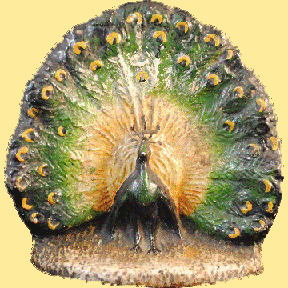 I
have several old cast-iron doorstops that I’ve picked up here and there
over the years. I wouldn’t go so far as say that I have a collection,
but I have maybe a half dozen. Can you tell me anything about these
doorstops? I
have several old cast-iron doorstops that I’ve picked up here and there
over the years. I wouldn’t go so far as say that I have a collection,
but I have maybe a half dozen. Can you tell me anything about these
doorstops?
Thanks,
Janet
__________________________________________________________
ANSWER:
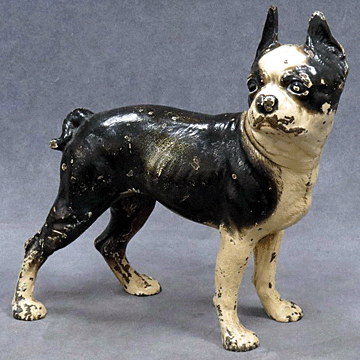 Your
doorstops are most likely from the late 19th century or the early
20th. The British made what they called “door porters,” after door
attendants, around 1770, after the invention of the butt-hinged
door, which closed automatically. To prevent the door from closing
by itself, people began to prop heavy items in front of it, thus the
name “doorstop.” Your
doorstops are most likely from the late 19th century or the early
20th. The British made what they called “door porters,” after door
attendants, around 1770, after the invention of the butt-hinged
door, which closed automatically. To prevent the door from closing
by itself, people began to prop heavy items in front of it, thus the
name “doorstop.”
Makers of early doorstops made them not of cast iron but of molded
earthenware and fitted with an upright rod, or handle, about 18
inches long, which eliminated the need for bending down to move the
stop from place to place. In succeeding years, doorstops might be
fashioned from earthenware,
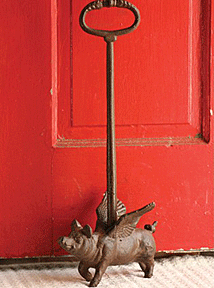 wood,
marble, or glass—several New England glass companies created glass
doorstops shaped like turtles during the 19th century. All were
heavy enough or sufficiently weighted to work well. wood,
marble, or glass—several New England glass companies created glass
doorstops shaped like turtles during the 19th century. All were
heavy enough or sufficiently weighted to work well.
However, makers created doorstops mainly from bronze, brass, and
iron. Brass ones—usually with a weighted base—often resembled a
solid bell sliced in half and fitted with a long handle. Around
1810, handles generally disappeared from doorstops. Newer, knobbier
shapes—some with built-in handles that permitted easy grasping came
into vogue. Yet the Victorian brass doorstops with rod-like handles
can still be found today.
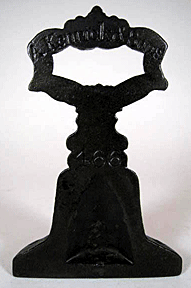 The
early 1800s heralded brass doorstops in a broad variety of classical
and traditional designs. A bit later—in response to improved
techniques in the casting of iron—a long and fanciful parade of
cast-iron doorstops began their prolonged march from English iron
factories. Some were full figured while others were flat backed and
similar to the popular Staffordshire-pottery images of cottages and
animals that captivated English hearts during the 1800s. Figures of
Punch and Judy, Shakespearean characters, and such historical
persons as Benjamin Disraeli and the Duke of Wellington emerged. The
early 1800s heralded brass doorstops in a broad variety of classical
and traditional designs. A bit later—in response to improved
techniques in the casting of iron—a long and fanciful parade of
cast-iron doorstops began their prolonged march from English iron
factories. Some were full figured while others were flat backed and
similar to the popular Staffordshire-pottery images of cottages and
animals that captivated English hearts during the 1800s. Figures of
Punch and Judy, Shakespearean characters, and such historical
persons as Benjamin Disraeli and the Duke of Wellington emerged.
Though iron became an building material, cast-iron doorstops didn’t
appear until after the Civil War. These doorstops varied greatly in
size. A frog-shaped doorstop might measure little more than three
inches high while a cat might be as tall as 19 inches. Others ranged
from 6 to10 inches high. Those issued from the 1850s until about
1900 were heavier than later ones, as they appeared when brass and
iron were less costly and more freely used.
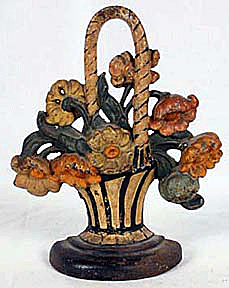 The
majority of metal doorstops found nowadays at antiques shows and
shops originated during the late 1800s and early 1900s, and their
design is often the key to determining their vintage. A figure of a
Scottie dog, for instance, points to the 1920s and 1930s, when this
breed of dog was popular and appeared on everything from jewelry to
playing cards. Similarly, a painted, stylized vase of
bright-blooming flowers corresponds to the 1920s–30s Art Deco
period. The
majority of metal doorstops found nowadays at antiques shows and
shops originated during the late 1800s and early 1900s, and their
design is often the key to determining their vintage. A figure of a
Scottie dog, for instance, points to the 1920s and 1930s, when this
breed of dog was popular and appeared on everything from jewelry to
playing cards. Similarly, a painted, stylized vase of
bright-blooming flowers corresponds to the 1920s–30s Art Deco
period.
Thayer & Chandler of Chicago, maker of artists' supplies, and Hubley,
a toy-maker, both issued doorstops. In the early 1900s, Thayer &
Chandler helped popularize the baskets or vases of flowers that
collectors now favor.
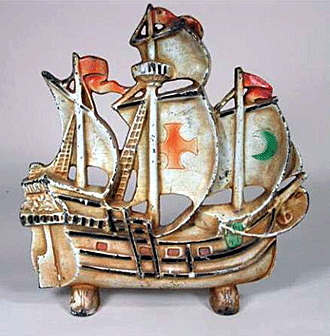 During
the past 10 years, prices of doorstops
have risen markedly. It's not uncommon to find
an unusual or rare figural—two kittens in colorful painted attire or
an American Indian—selling for hundreds of dollars. However, an
aware buyer can find antique doorstops for under $100—some for even
as little as $50. Most sell in the $75-90 range. Rare ones can go
for as high as $300. It’s important to look for old doorstops that
still have a amount of their original paint since repainting
decreases the value of an old piece. During
the past 10 years, prices of doorstops
have risen markedly. It's not uncommon to find
an unusual or rare figural—two kittens in colorful painted attire or
an American Indian—selling for hundreds of dollars. However, an
aware buyer can find antique doorstops for under $100—some for even
as little as $50. Most sell in the $75-90 range. Rare ones can go
for as high as $300. It’s important to look for old doorstops that
still have a amount of their original paint since repainting
decreases the value of an old piece.
Many collectors acquire doorstops to those with a specific motif,
such as those with a nautical flavor—lighthouses, clipper ships,
mariners---or others with a Western theme---Indians, cowboys,
stagecoaches. There are also collectors who seek monkeys, ducks,
clowns, gnomes, and so on.
|
<
Back to Readers Ask Archives Next Article
>
|

|
|
FOLLOW MY WEEKLY BLOG
Antiques Q&A
JOIN MY COLLECTION
Antiques and More
on Facebook
LIKE MY FACEBOOK PAGE
The Antiques
Almanac on Facebook |
|
No antiques or collectibles
are sold on this site.
|
|
How to Recognize and
Refinish Antiques for Pleasure and Profit
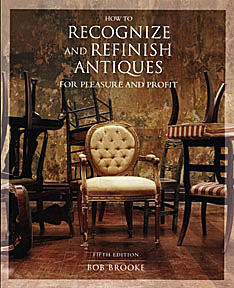
Have
you ever bought an antique or collectible that was less than perfect and
needed some TLC? Bob's new book offers tips and step-by- step
instructions for simple maintenance and restoration of common antiques.
Read an
Excerpt
|
|

|
|
|
|
|
